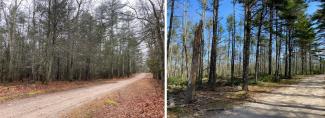DEM Announces Brush-Clearing Project to Lessen the Threat of Uncontrolled Wildfire at Arcadia Management Area
Published on Thursday, January 18, 2024
PROVIDENCE, RI – The Department of Environmental Management (DEM) is announcing that it will conduct a project of thinning dense tree cover and removing underlying brush at the state’s largest recreation area, Arcadia Management Area. Starting this month weather permitting, a crew of professional foresters will create a shaded fuel break along various stretches of forestland bordering the fire roads of Arcadia, a 14,000-acre mostly wooded parcel spanning Exeter, Hopkinton, Richmond, and West Greenwich in Hope Valley.
The aim of a shaded fuel break is to reduce and manage fuels within a designated area to lessen the risk of a wildfire becoming an uncontrolled wildfire. A fuel break is not a firebreak. A firebreak is a natural or built barrier to stop or check fires that may occur. A firebreak denies a fire fuel – meaning nearby combustible material – and is used to prevent advancing surface flames from coming into direct contact with homes and other buildings.
On the other hand, in thinning and cutting shrubs, underbrush, and some trees, and clearing downed and dead branches to create a fuel break, foresters are removing fuels, thus limiting a fire’s speed and severity. Unlike a firebreak, a shaded fuel break does not remove all vegetation in an area. A fuel break by itself will not stop a wildfire, but it will help reduce fire speed and severity, hopefully making it easier for ground crews to suppress the fire. Last, shaded fuel breaks maintain cooler and moister understory conditions and understory vegetation remains greener longer into the growing season. This also helps to reduce fire spread.
“We have two major goals in carrying out this work,” said DEM Division of Agriculture and Forest Environment Deputy Chief Tee Jay Boudreau. “First is protecting life and property in the event of an advancing wildfire by reducing risk through active hazardous fuels management on Rhode Island state lands. Second, and just as important, is aiding in fire suppression efforts from responding fire departments and in so doing, improving firefighter safety on state lands.”
The $360,000 project is being funded using $3 million that was designated for forest health projects at state management areas in the 2022 green bond. Notwithstanding recent above-average rainfall accumulations, Rhode Island has become a hotter and drier place in large part due to climate change. The state experienced a busy wildfire season in 2023, with DEM recording 78 wildfires encompassing 582 acres. This total includes the Congdon Mill Fire in West Greenwich that covered nearly 196 acres and the worst-in-decades Queen’s River fire in Exeter that burnt 286 acres. These latter two fires happened back-to-back in April 2023.
Creating fuel breaks that border existing interior fire roads on state lands goes hand in hand with keeping these roads clear to aid firefighting efforts. The DEM Forest Fire Program has mapped out all priority roads at Arcadia and planned the fuel breaks to work in conjunction with the fire roads, acting somewhat as a firebreak. This will strengthen firefighters’ ability to reduce fire speed and severity. Implementing this strategy involves some cutting, but as the picture on the previous page shows, leaves behind many mature, well-spaced, healthy trees with carbon sequestration value. It is not clear cutting.
Peer-reviewed research in the September 2023 issue of the academic journal Forest Ecology and Management found that fuel breaks “clearly change wildfire behavior by reducing the intensity of the flames, thus reducing the level of burn severity and preserving vegetation health.” The article continued, “The postfire observations indicate that the fuel break region contained trees that were still intact with green crown canopies, whereas the surrounding untreated region was severely damaged with no preservation of tree canopies, leaving only the stumps and bare trunks…Overall, the fuel treatment was effective at reducing the burn severity, thereby preserving the health of the trees within the fuel break.”
For more information on DEM programs and initiatives, visit www.dem.ri.gov. Follow DEM on Facebook, Twitter (@RhodeIslandDEM), or Instagram (@rhodeisland.dem) for timely updates.

